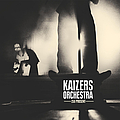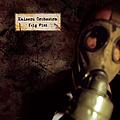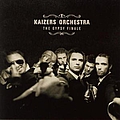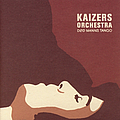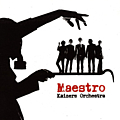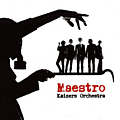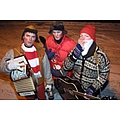Kaizers Orchestra Biography
Kaizers Orchestra is a Norwegian alternative rock group, formed in Bryne, Rogaland, Norway on January 1, 2000. The current band members are Janove Ottesen (a.k.a. "The Jackal", lead vocal), Geir Zahl (a.k.a. "Hellraizer", second guitar, second vocal, oil barrels), Rune Solheim (a.k.a. "Mink", drums), Terje Winterstø Røthing (a.k.a. "Killmaster", first guitar, oil barrels, backing vocals), Øyvind Storesund (a.k.a. "Thunder", double bass, whistler) and Helge Risa (a.k.a. "Omen", pump organ, piano, accordion, marimba). The sextet is well known both in their native country and Europe for their energetic live shows, the interlocking stories found in their lyrics - concerning the mafia, war, underground resistance groups and mental institutions - as well as their trademark Danish civilian gas mask from the 1940s, worn by Risa. The band was started by the two childhood friends Janove Ottesen and Geir Zahl, who had earlier played in several bands together, such as Blod, snått & juling and gnom. Similar to their earlier compositions, the lyrics for virtually all songs are written in the Ottesen and Zahl's native dialect from their hometown of Bryne, Norway. The musical and lyrical style of Kaizers Orchestra was in part conceptualized during the active period of their former band, gnom. Despite the release of a studio album, Mys, any recognition eluded gnom. However, one song written during gnom's active period, called "Hemmelig Beskjed", featuring a musical style defined by the group as "ompa" music, which elicited significant response from live audiences. This inspired Ottesen to compose a new song, "Bastard"; the song's melody and lyrics, clearly inspired by Tom Waits, as well as the unusual inclusion of oil barrels as percussion, inspired them to reinvent their sound, image and name. While Ottesen and Zahl's past bands had a decidedly more folk/pop sound, Kaizers Orchestra was going to be entirely different. Drummer Rune Solheim and organ player Helge Risa who had been playing with them in gnom, joined the new band. Jon Sjøen, an educated musician, also joined as their stand-up bass player. Throughout 2000, the five-piece group performed sporadically at various small venues in Norway, having received little to no publicity at the time. In July, Ottesen and Zahl performed acoustic shows at Det Beste Stedet in Sandnes, their sets consisting of partly Blod, Snått & Juling, gnom and newly-written Kaizers Orchestra material. As a five-piece group, a 14-track demo was recorded, but Ottesen and Zahl grew frustrated at finding it hard to bring their vision for the band to tape. They recorded an unnamed EP in 2000, known as Gul EP (Yellow EP), featuring a recording of "Bastard" (which had, despite its response, not been recorded while gnom was active). After months of struggling, they finally signed a deal with the indie label BroilerFarm. In 2001, Terje Vinterstø joined the band as their first guitarist. In the studio, producer Jørgen Træen succesfully managed to capture Ottesen and Zahl's vision for the band's sound, and the album was recorded in six days, leaving the last day for partying. Their debut album, Ompa til du dør, was released on September 1, 2001, receiving high praise from critics and launching them into the national spotlight. The album would go on to win a Spellemannspris (the Norwegian equivalent of the Grammy Awards) and become the best-selling Norwegian rock album of all time. Subsequently, as bookings became more and more frequent, Kaizers Orchestra performed in nearly every part of Norway until the end of the year. Early 2002 saw the release of their second EP, Død manns tango. In the summer, they released another EP, Mann mot mann and played their first show outside of Norway; at the prestigious Roskilde Festival, to much critical praise. In January 2003, they performed as part of the Eurosonic festival in Groningen, the Netherlands, where they made a huge impression on both festival-goers and people high up in the music business. On February 3, 2003, their second studio album, Evig pint was released. This album was cited as having a darker atmosphere, and included only one song featuring oil barrels, which had become a trademark for the band by then. The album did not receive as much critical praise as their debut album, nor did it sell that well. Despite this, the band went on a highly succesful tour, now often including shows outside of Norway as well, helping to build an international fanbase. Later in 2003, Kaizers released a remastered version of their gnom record, Mys, including a recording of "Bastard", despite the fact that the track had been recorded only after the band's dissolution. In 2004, they signed a record deal with Universal Germany and most of their material was re-released across Europe. By this time, the band had performed in nearly all major countries in Europe. In 2005, they released their third studio album, Maestro, which was released in certain European countries as well as Norway. The album received a majority of positive reviews, however, some were disappointed (the album received the lowest marks given from a Swedish magazine in some time) and the album failed to sell as well as the record company planned, something which the band blamed on little support and promotion from Universal Germany. Nevertheless, the Kaizers embarked on the "Maestro Tour", spanning over ten countries, lasting until early 2006. After the release of their first live album, Live At Vega and live DVD, Viva La Vega in 2006, Kaizers announced that they were going to have a one-year hiatus from performing in 2007. The "Grand Finale Tour" commenced, spanning more than 10 countries, culminating in four consecutive shows at Vega, Copenhagen, Denmark; the same concert hall in which Live at Vega and Viva La Vega were recorded. Also in 2006, a book about Kaizers Orchestra and their past, present and future, chronicling their rise from small-time guitar duo to one of the better-known live acts ever from Norway, Kontroll på kontinentet was released. It was written by Geir Zahl's brother Jan Zahl, and featured photos taken by their staff photographer Paal Audestad. Despite their previously announced hiatus from live performances, the band played three shows in 2007; One at their old favourite, the club Folken in Stavanger, at the Documenta 12 art expo in Germany, and the Sziget Festival in Hungary. Shortly after the Sziget show, the Kaizers released information about their untitled fourth album. The album title was revealed to be Maskineri in December 2007, and on Monday, December 17, they released the first single from the album, called "Enden av November", which also had a video shot for it. Maskineri was released on February 18, 2008. It received favourable reviews from most of Scandinavia. The Kaizers' Maskineri tour that soon followed received great response and was followed up by a summer tour, with the band performing at various festivals throughout Europe. In the fall of 2008, the band released 250 Prosent, a live compilation album featuring recordings from the Maskineri Tour. Shortly thereafter, the band embarked on the 250 Prosent tour, where they played rare songs that they had dropped from setlists long time ago or never really played much in the first place. Very few songs from Maskineri were incorporated into the setlists. Early in 2009, Kaizers Orchestra released information concerning a new upcoming album called Våre Demoner; a compilation of re-recordings of songs written during their entire musical career, that did not fit into their four previous albums. Some of the songs that ultimately appeared on Våre demoner had been leaked through various sources (against the band's wishes), among them the titular song "Våre Demoner", of which a demo version was leaked. The album was released in limited quantities on April 27, 2009, followed by a subsequent mini-tour of small venues in Norway. In 2007, Ottesen composed two to three songs a day for ten days. In the fall of 2009, basic information regarding the upcoming studio album was released, citing a 2011 release date. The band announced a Studio Tour of venues across Norway; the proceedings from these concerts were to finance the next studio album. Ticketholders attending these events were to be given a special edition of the new album. On February 10, 2010, the album's title as well as the format in which it is released came to light; a series of three albums, three volumes in a series known as Violeta Violeta will be released in 2011 and 2012. The first single from the first volume of the trilogy was "Philemon Arthur & The Dung", released digitally on August 24, 2010.
Top Kaizers Orchestra Lyrics
Write a comment
What do you think about Kaizers Orchestra? Let us know in the comments below!
Top Kaizers Orchestra Albums
Similar artists
- Janove OttesenFolk/Indie
- VampFolk
- SuperfamilyIndie/Rock
- PostgirobyggetRock











